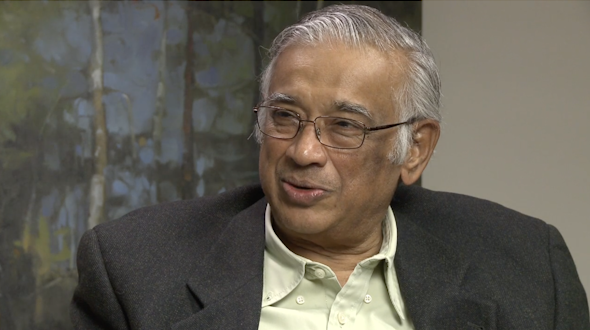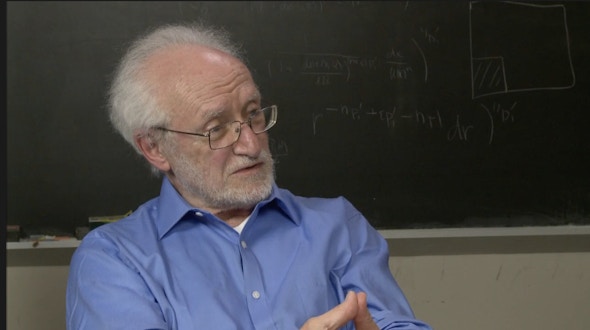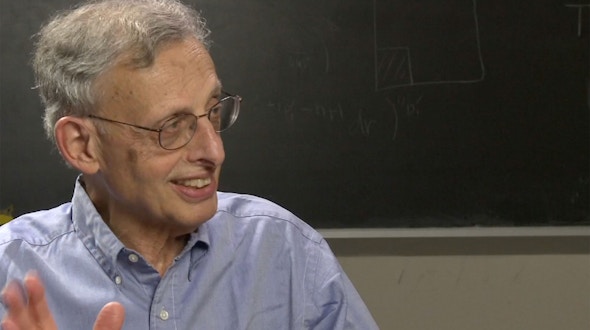John Conway (1937 – 2020)
- Highlights (2:44)
- Discovery of Conway Groups (9:27)
- Regular Algebra and Finite Machines (2:46)
- My Job is to Simplify Things (1:38)
- The Life Game (10:21)
- The Life Game and Von Neumanns First Computer (4:53)
- PRIMEGAME (3:46)
- Childhood Interest in Mathematics (7:23)
- Besicovitch as a Teacher (8:25)
- Discoveries with Games Surreal Numbers ()
- Dots and boxes and Elwyn Berlekamp (12:29)
- On the Book: Numbers and Games (3:13)
- Friendship with Elwyn Berlekamp (4:52)
- Five Rainbows (15:49)
- Relationship with Harold Davenport and Waring's Theorem (10:16)
- Teaching at Cambridge and Moving to Princeton (4:37)
- Atlas of Finite Groups (3:20)
- Bringing Groups to Princeton (3:31)
- Sphere Packings Lattices and Groups (5:24)
- The Monster (8:26)
- Fractran Program (8:14)
- Martin Gardner Stories (17:36)
- Staying with Martin Gardner (6:00)
- The Three by Three Game (2:03)
- Hackenbush Game (8:42)
- Lexicodes (15:26)
- Adapting to Princeton (3:31)
- On the Simplicity of Games (3:36)
- Why Games are Interesting (6:58)
- Gödel as God (2:07)
- Stan Tennenbaum and Gödel (6:26)
- C W Gibby Durham and Percy John Heawood (2:56)
- Four Color Theorem and Computer Proofs (15:32)
John Horton Conway, a wildly prolific and highly decorated fellow of the Royal Society with an Erdös number of one (meaning that he collaborated with the legendary mathematician Paul Erdös), has over the course of his career made a name for himself by means of a rather suspect modus operandi. While most high-powered mathematicians shut themselves away in their office and put pencil to paper in hopes of cranking out proofs and theorems, Conway is known to while away his days tinkering and daydreaming. Or, as he himself puts it, playing games and basically doing nothing.
Long since crowded out of his office by the wanton mess (the fire marshal declared it a hazard because of all the toys, loose paper and garbage scattered about, as well as all the geometrical models hanging from the ceiling, warming on the radiator and tiling the floor), he can almost always be found at one of two stations in the Princeton University mathematics department. One of them is a cluster of couches in the common room, where he uses the communal math bat phone for his own. The other is a spot just outside the fray in the hallway, a window alcove furnished with two armchairs facing a blackboard, with a comfortable amount of legroom in between.
Here he does his tinkering. It’s where he created his latest masterpiece, the Free Will Theorem, devised together with his Princeton colleague Simon Kochen. The theorem uses quantum mechanics as well as some geometry and philosophy to prove that if human beings have free will, then elementary particles have free will as well, and thus, Conway figures, it goes a long way toward explaining why humans have free will in the first place.
He is perhaps best known for inventing the Game of Life, a cellular automaton that evolved into existence after years and years of fiddling, this time in the mathematics common room at the University of Cambridge, where Conway studied as an undergraduate, received his doctorate, and subsequently taught until 1986. He played around endlessly with simple board-game markers, like stones or checkers, on a theoretically infinite grid. Aided and abetted by a loyal following of graduate students, he searched and searched for a simple set of rules, with the goal of producing a universal Turing machine, a computer whose algorithm includes all algorithms.
He is also well-known for the Conway group — for three groups actually, three inter-nested sporadic simple groups, the largest of which is of order 4,157,776,806,543,360,000. This discovery, as Conway likes to recount, was made entirely in his spare time in hopes that it would make his career. He decided to lock himself into his home office every Wednesday from 6 p.m. to midnight and every Saturday from noon to midnight for as long as it took. He emerged triumphant after the first 12-hour stint.
As Thomas Edison once said, “Genius is 1 percent inspiration, 99 percent perspiration.” Which is to say that Conway is working hard when he is doing his purported nothing, and he does this purported nothing nearly every waking hour of every day. For example, even he admits that executing his Doomsday Rule — an algorithm he invented whereby he can, within seconds, compute the day of the week for any date in history upon request — makes him mentally and physically break out in a sweat, even though he has practiced it, testing and timing himself with his computer or competing against formidable grad student challengers, for years on end.
•••
As the Doomsday party trick may suggest, Conway is also known as a great popularizer of all things mathematical. He never misses a chance to explain the latest mathematical delicacy occupying his brain. If one day you happened by his alcove while he was whiling away the time, he might bellow:
Welcome! It’s a poor place but mine own!
Then he’d clear the spare chair of the day’s debris — The New York Times, which he devours back-to-front with the morning’s bagel and coffee, his page-a-day Sudoku calendar, and a landslide of loose paper on which he’s been running columns of numbers, playing not just any pointless game but a pointless game he recently invented. Subprime Fibs, he calls it, after the subprime mortgage crisis and the Fibonacci numbers (the sequence of numbers that begins 0, 1, with all subsequent numbers being the sum of the previous two — 0, 1, 1, 2, 3, 5, 8, 13, and so on).
The one and only rule of Subprime Fibs goes like this: Take any two numbers and write them down. Then add them up. If the sum is a prime number — a number divisible only by 1 or itself — write it down as well. If the sum is not prime, divide it by the smallest prime divisor and write down that result. Then take the last two numbers written down, and repeat the process. And continue to repeat it.
Hoisting himself out of his armchair, Conway affably offers a blackboard demonstration, adding as a disclaimer,
I know you’re not really interested but I’ll show you anyway because you were foolish enough to ask.
1 and 1 make 2, and that’s prime. So I write it down.
1 and 2 make 3, and that’s prime.
2 and 3 make 5, which is prime.
3 and 5 make 8, which isn’t prime, so I divide it by the smallest prime I can, which is 2, and I get 4.
5 and 4 make 9, which isn’t prime, divide it by 3 and I’ll get 3, which is prime.
That’s what you do.
And what you get is this sequence:
1, 1, 2, 3, 5, 4, 3, 7, 5, 6, 11…
What would Conway call this kind of number game?
A waste of time!
However, what’s fascinating about the rule governing the game, for the man who invented it anyway, is that it’s totally stupid but yet it exists.
I’ll tell you what interests me about this — it’s really what interests me about mathematics. Nobody else in the whole history of the world has been stupid enough to invent this rule. That’s the first thing. But then, if they had, they would find exactly this behavior that I’m finding.
And what I’m conjecturing now is that whatever two numbers you start with, no matter how big they are, the sequence ends up in a cycle, it just goes round and round and round. It seems no matter which pair of numbers you start with, it ends up being periodic, it repeats after a certain number of steps, as is the case with the sequence I just did.
Here is the sequence as it progresses to a repeating cycle:
1, 1, 2, 3, 5, 4, 3, 7, 5, 6, 11, 17, 14, 31, 15, 23, 19, 21, 20, 41, 61, 51, 56, 107, 163, 135, 149, 142, 97, 239, 168, 37, 41, 39, 40, 79, 17, 48, 13, 61, 37, 49, 43, 46, 89, 45, 67, 56, 41, 97, 69, 83, 76, 53, 43,
48, 13, 61, 37, 49, 43, 46, 89, 45, 67, 56, 41, 97, 69, 83, 76, 53, 43,
48, 13, 61, 37, 49, 43, 46, 89, 45, 67, 56, 41, 97, 69, 83, 76, 53, 43,
48, 13, 61, 37, 49, 43, 46, 89, 45, 67, 56 …
I can’t say it always repeats. Because I haven’t proved it. But it’s as obvious as hell that it always does. And, how can I say it, even though nobody’s ever looked at it — and I’m absolutely sure that nobody’s ever looked at it; I mean, it’s not inconceivable that somebody’s invented it, but why the hell should they have, you know? — but if they had, they would have found this.
That’s a curious thing about the nature of mathematical existence. There is this abstract world which in some strange sense has existed throughout eternity. This rule hasn’t physically existed in any sense in the world before a month ago, before I invented it, but it sort of intellectually existed forever.
•••
The same sense of discovery holds true for many if not all of Conway’s mathematical works. Take, for instance, surreal number theory. This is the discovery of which Conway is proudest, a discovery he made — yet again! — while sitting around doing nothing at Cambridge. As at Princeton, during most of his time at Cambridge Conway maintains that he was just lazing about playing games. The game of Go was all the rage at the time. Conway never actually played it himself — the rules are too complicated, he says, adding,
It’s not God’s game!
He did, however, spend a good amount of time watching people play Go, staring at the board, observing the strategy, trying to figure out what was Going on, so to speak. He also played a lot of games with his four daughters, and he still does with the youngest of his three sons, the sixth grader Gareth — games like Nim and Domineering and Hackenbush. Conway realized early on that games behave a lot like numbers, and numbers behave a lot like games. From this insight he derived his surreal number theory.
A “number” in Conway’s scheme is an ordered pair of sets, called L and R, written {L | R}, and as governed by two rules which can be simply stated as follows:
- If L and R are 2 sets of numbers, and no member of L is ≥ any member of R, then there is a number {L | R} (which turns out to be the simplest number strictly between L and R).
- All numbers are created in this way.
For a slightly more nuanced description of the numbers and their rules, here is an excerpt from Stanford computer scientist Don Knuth’s novella, “Surreal Numbers: How Two Ex-Students Turned on to Pure Mathematics and Found Pure Happiness”:
In the beginning, everything was void, and J.H.W.H. Conway began to create numbers.
Conway said, ‘Let there be two rules which bring forth all numbers large and small.
This shall be the first rule: Every number corresponds to two sets of previously created numbers, such that no member of the left set is greater than or equal to any member of the right set.
And the second rule shall be this: One number is less than or equal to another number if and only if no member of the first number’s left set is greater than or equal to the second number, and no member of the second number’s right set is less than or equal to the first number.’
And Conway examined these two rules he had made, and behold! They were very good.
Or for an even more detailed account, see Conway’s book On Numbers and Games.
With that definition in place, the surreal numbers — a simple play, if you will, on the definition of Dedekind cuts — evolved to encompass all numbers, infinite and infinitesimal. One might have assumed that the job of classifying numbers was already complete, but the surreals illustrate how even the number system is a continually evolving notion in mathematics. As Conway himself acknowledges,
It’s sort of unbelievable, how many numbers there are!
In striving to express the effect the surreals had on him — and by extension the effect of all mathematics — Conway rattles off a few lines from Keats’ sonnet “On First Looking Into Chapman’s Homer”:
Then felt I like some watcher of the skies
When a new planet swims into his ken;
Or like stout Cortez when with eagle eyes
He star’d at the Pacific — and all his men
Look’d at each other with a wild surmise —
Silent, upon a peak in Darien.
I can’t say that I invented the surreal numbers; I discovered them, the way Cortés didn’t invent the Pacific Ocean. He didn’t really discover it either, it was already known, but you see what I’m getting at. I’m talking about explorers who discover something new.
Here was this absolutely enormous world, and I was the first person to see it, even though it was an abstract world. You could stop anywhere and pick up a new flower, as it were, and have a look. I walked around for weeks in a daydream, thinking, “Isn’t this a fabulous world, and you discovered it, John.” There was always that in the back of my mind, some self-congratulation.
Conway’s characterization of himself as an egomaniac is another favorite shtick he playfully pulls out, second only to his habitual self-deprecation about sitting around frittering the days away.
But despite all his protestations of laziness, it is widely accepted that Conway’s egomania is justified — that he possesses a brain the size of a planet, which when put to good use really can cogitate at the speed of light.
Indeed, a couple years ago he traveled to Canada at the request of the neuroscientist who studies specimens of Einstein’s brain, and who now wishes to investigate Conway’s. He participated in a battery of IQ tests and submitted himself to a functional MRI scan that created three-dimensional pictures of his brain while he lay flat on his back calculating and cogitating — that is, while he did nothing, essentially.
Siobhan Roberts’ biography — “Genius at Play: The Curious Mathematical Mind of John Horton Conway” — will be published by Bloomsbury in spring 2015.



